People often ask what is an IoT gateway. What is the role of a gateway? Do I need a gateway? As an IoT practitioner, I often face these questions. In this article, as an engineer, I will introduce you to the definition of an IoT gateway, its role, and its applications.
What is an IoT Gateway?
An IoT gateway is essentially a smart central hub for IoT devices. IoT gateway devices link Internet of Things (IoT) devices to the cloud and one another, translating IoT device communication and filtering data into useful information.
The backend platforms (data, device, and subscriber management) and end devices (sensors, actuators, or more complex devices) connect to the IoT gateway through communication technologies. It has a computing platform that enables pre-installed or user-defined applications to manage data, devices, security, communication, and other gateway-related functions (for routing and computing at the edge).
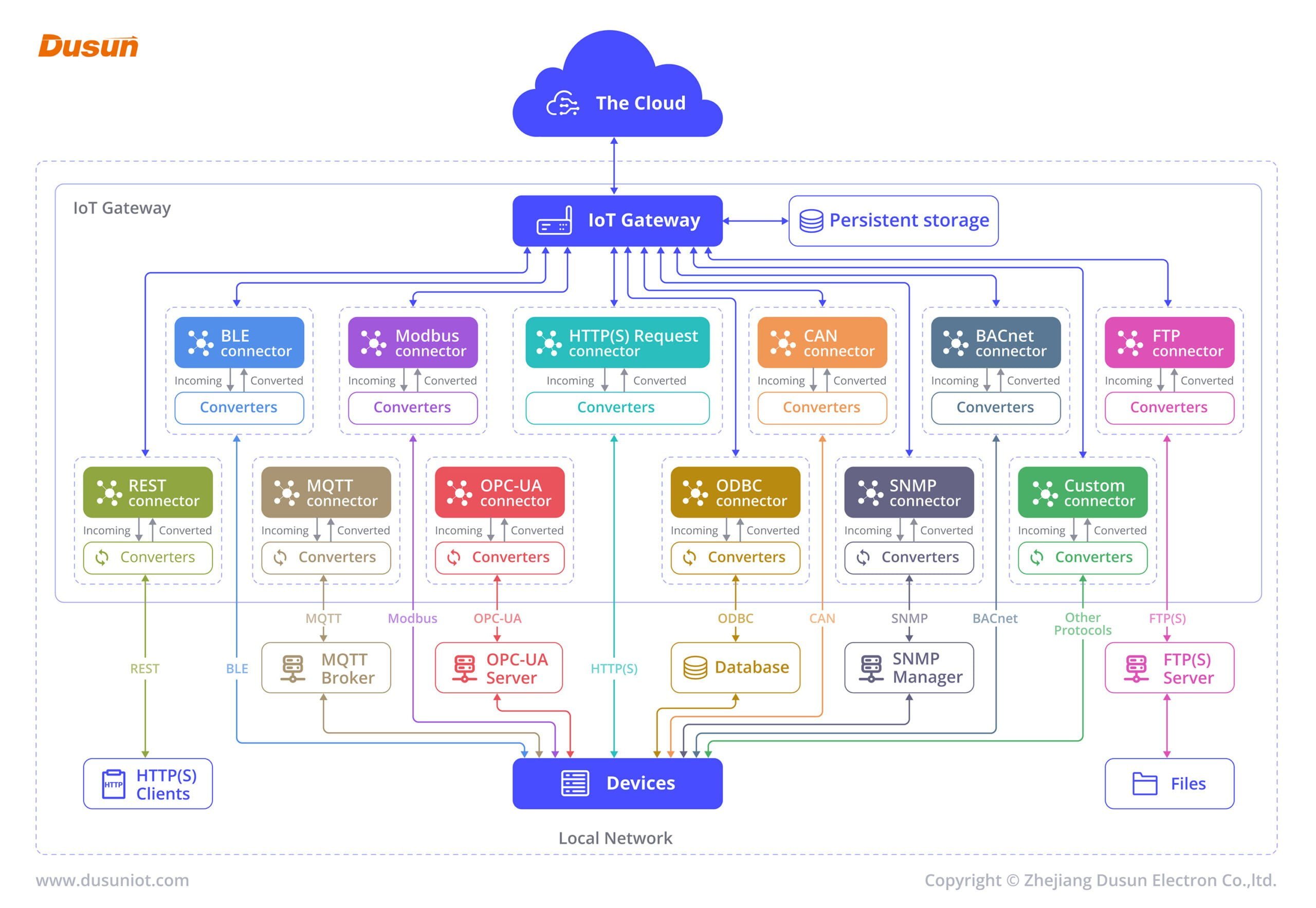
What is IoT?
IoT refers to all Internet-connected devices. Still, it is increasingly used to describe all “smart” devices, including watches, refrigerators, cars, and others that “talk” to each other. These systems create a network of physical “things” that communicate over the Internet. Wireless networks and cheap computer chips allow anything to join the Internet of Things.
Smart toasters, connected thermometers, and cat collars are Internet-connected devices. App-controlled office lights, thermostats, motion sensors, and light bulbs are IoT devices. Computers have many sensors, but they’re not considered Internet of Things (IoT) devices like smartphones. Smartwatches, fitness bands, and other wearables may be IoT devices.
Intelligent, embedded “things” form the IoT architecture (processors, sensors, and hardware). These devices use environmental data to send, manage, and store data and systems. IoT devices use gateways, platforms, or other devices to analyze and share sensor data. The IoT platform finds patterns, makes suggestions, and predicts issues. Machine learning and AI help IoT developers collect data faster and more dynamically (AI)
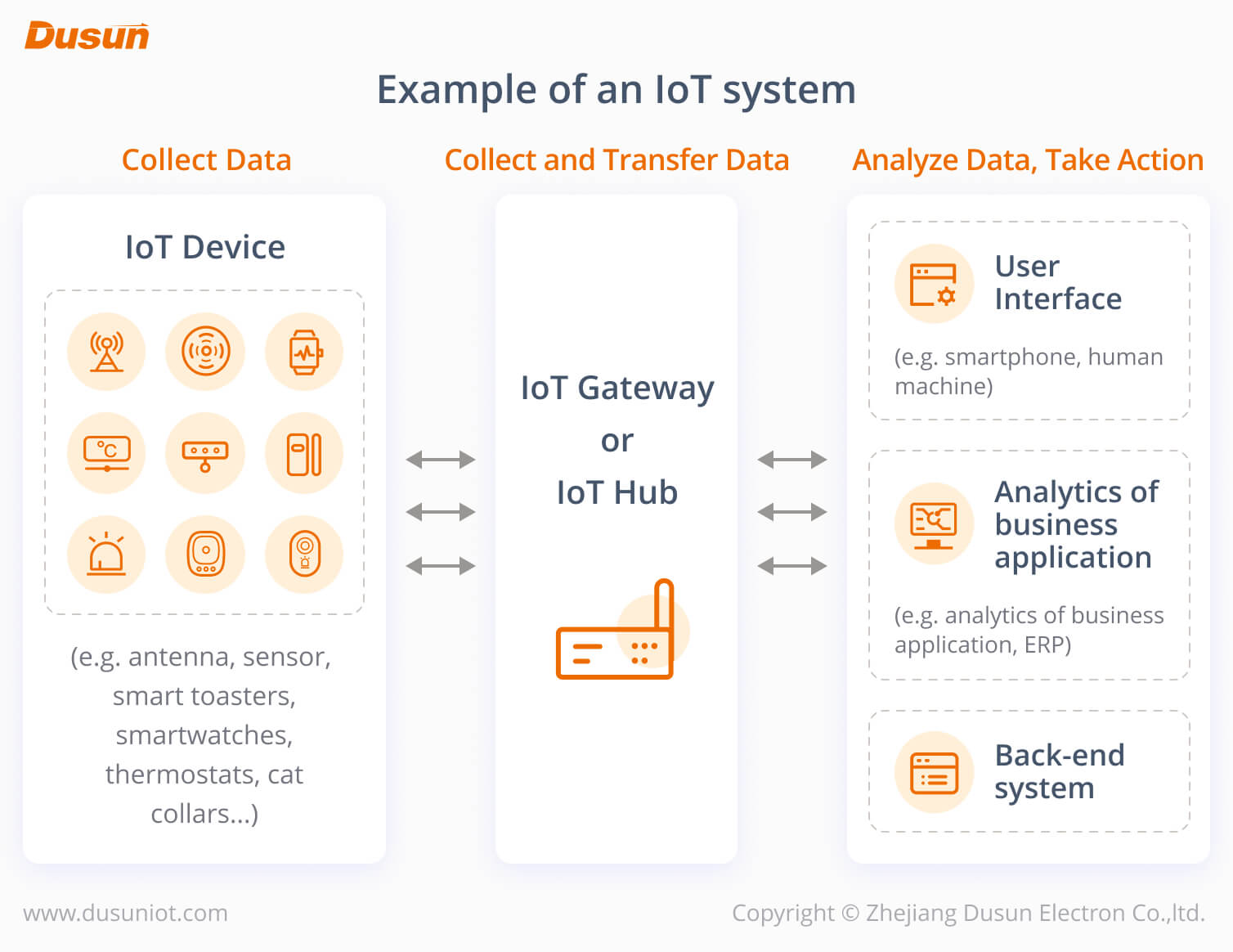
What Are the Components of the IoT Gateway?
Clearly, the components of the Internet of Things gateway will be different from one use case to the next. An Internet of Things Gateway is a low-powered computer that acts as an edge server. It is also capable of performing the duties of an internet router because it can establish a local internet network, just like the router in your home or workplace does.
The functionality to route internet traffic from and to the connected devices is provided as a result. In the case of a cellular router, the cellular module is what enables users to connect to the internet over a mobile network.
In most cases, Internet of Things gateways can connect to the internet using cellular data and fixed line internet by way of an ethernet port located on the device. It is possible to connect other devices to the gateway using a wide variety of methods, depending on the types of gateway being used.
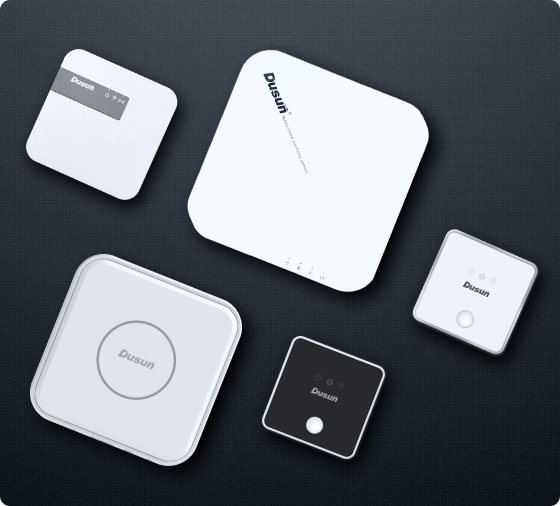
How Does an IoT Gateway Work?
IoT gateways use communication protocols to set up connections. Wireless or wired communications can be used to link the distributed IoT devices to the IoT gateway. IoTs may use a variety of transmission mediums, including WiFi, LoRa, LTE, and long-range wireless transmission protocols like Bluetooth LE, Zigbee, and Z-wave.
Explore these types of IoT gateway using different mainstream protocols:
- Bluetooth gateway
- ZigBee gateway
- Z-wave gateway
- LoRaWAN gateway
- Cellular gateway
- Sub-G gateway
- Matter gateway
The IoT gateway should use one or more of these transmissions to receive and send data. The IoT gateway may also use WiFi, 4G, 5G, or Fiber Optics WAN (HDLC/PPP) to forward data to the Cloud for outgoing traffic.
The IoT gateway may also comprehend and translate transmission modes and protocols such as MQTT, CoAP, AMQP, DDS, and Websocket to others required by data systems.
b. IoT gateways may pre-process the unprocessed data that IoT devices collect.
An IoT gateway receives large amounts of distributed raw data from IoT devices. To decrease data volume and consequently network latencies, some IoT gateways can aggregate, correlate, and synchronize all of this raw data. The IoT Edge gateway sends this “pre-processed” data after it establishes communication with the Cloud (or high-end server). Edge computing is the term used to describe this process.
Why Need an IoT Gateway?
IoT implementations in the real world face a number of difficulties. These sensors’ reliance on long-lasting batteries is a significant drawback. As a result, the battery will be depleted if you want to transfer data directly to the cloud, and users may need to constantly charge these devices. As a result, these sensors use mesh networking or low-power protocols like BLE to send their data to the gateway.
After arriving at the gateway, the data is then diverted to the cloud. These IoTs can also convert various protocols into ones that the cloud can comprehend. A gateway is thus unquestionably required at this point if you need to manage numerous IoT devices that need to transmit data in the cloud.
Architecture Overview
The gateway architecture diagram below is the most common architectural design where the gateway itself is not equipped with sensors. Gateway software installed on the device is responsible for collecting data from the sensors, preprocessing the data, and sending the results to the data center.
There are potential changes in this sensor architecture, some of which are located on the gateway device, as shown in the diagram below. It may be present in the gateway’s embedded sensors which can include options such as a GPS unit or a temperature sensor connected to the gateway using the GPIO interface.
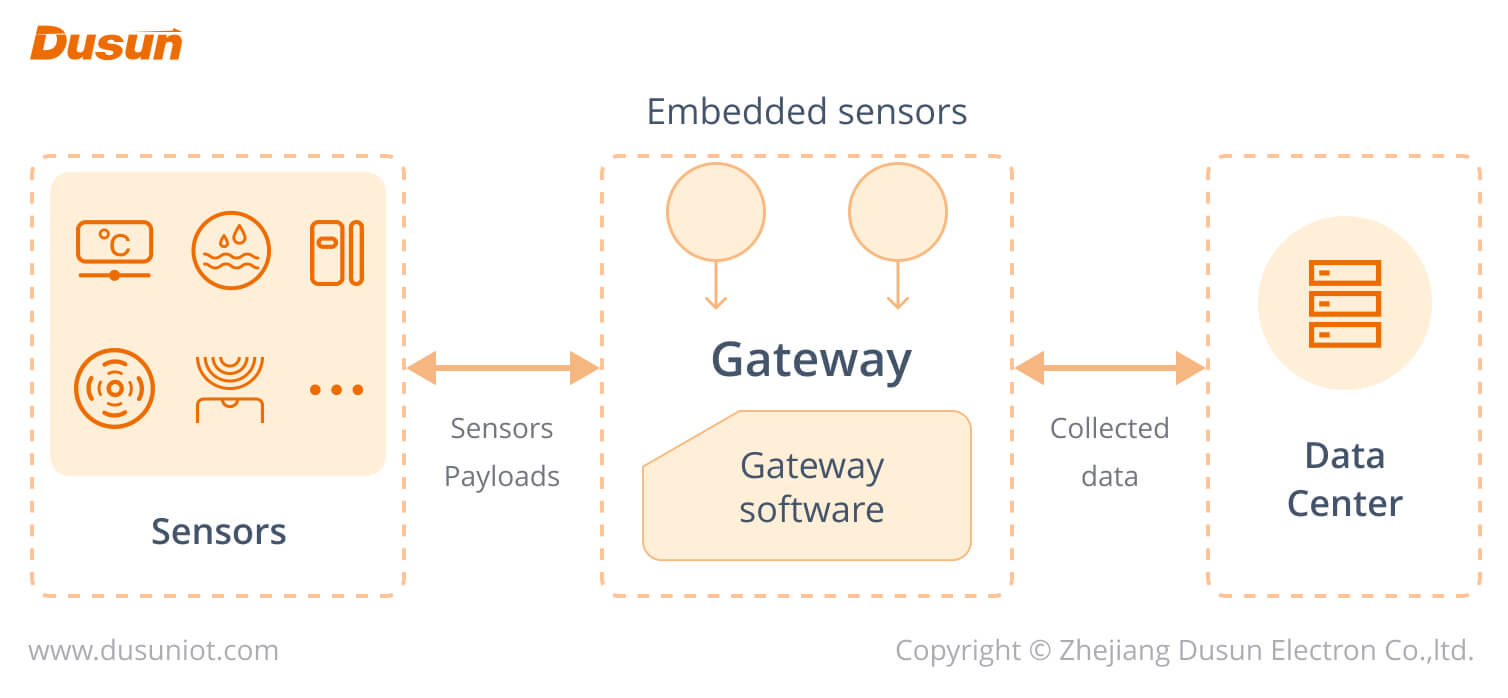
Software for Gateways
The gateway’s heart is comprised of software applications. The gateway software is in charge of collecting data from sensors and storing it properly until it can be pre-processed and sent to the data center. The gateway software determines whether the data at a given processing stage is temporary or persistent in memory.
Failure and disaster recovery should be considered when developing gateway software. Because gateway devices are frequently used in the field, you should expect less-than-ideal operating conditions.
Gateway software, for example, should be ready for power outages or other operations that could disrupt gateway processing. When power is restored, the gateway software should start automatically and continue to work from the point of interruption.
The gateway software should be intelligent enough to properly handle system logging. It must strike the proper balance between the number of log entries stored on the device and those sent to the data center.
There are three main solutions for gateway software entering the device.
The first method is pre-installing the software on the gateway disk (or memory card). This method is called factory bootstrap. As you might guess, this technique doesn’t scale well if your solution contains a lot of gateways.
The second method is server-initiated bootstrapping. In this mode, the central software management server communicates with the gateway device and deploys the correct version of the software to it. This approach scales better than factory bootstrapping but still requires the deployment operation to be initiated on the server side.
The third method is a client-initiated bootloader. This mode assumes that the gateway is responsible for connecting to the central repository server and downloading the appropriate version of the software. In this case, the gateway needs to have lightweight bootstrap software installed so that it can communicate with the software management server. This method is the most scalable method.
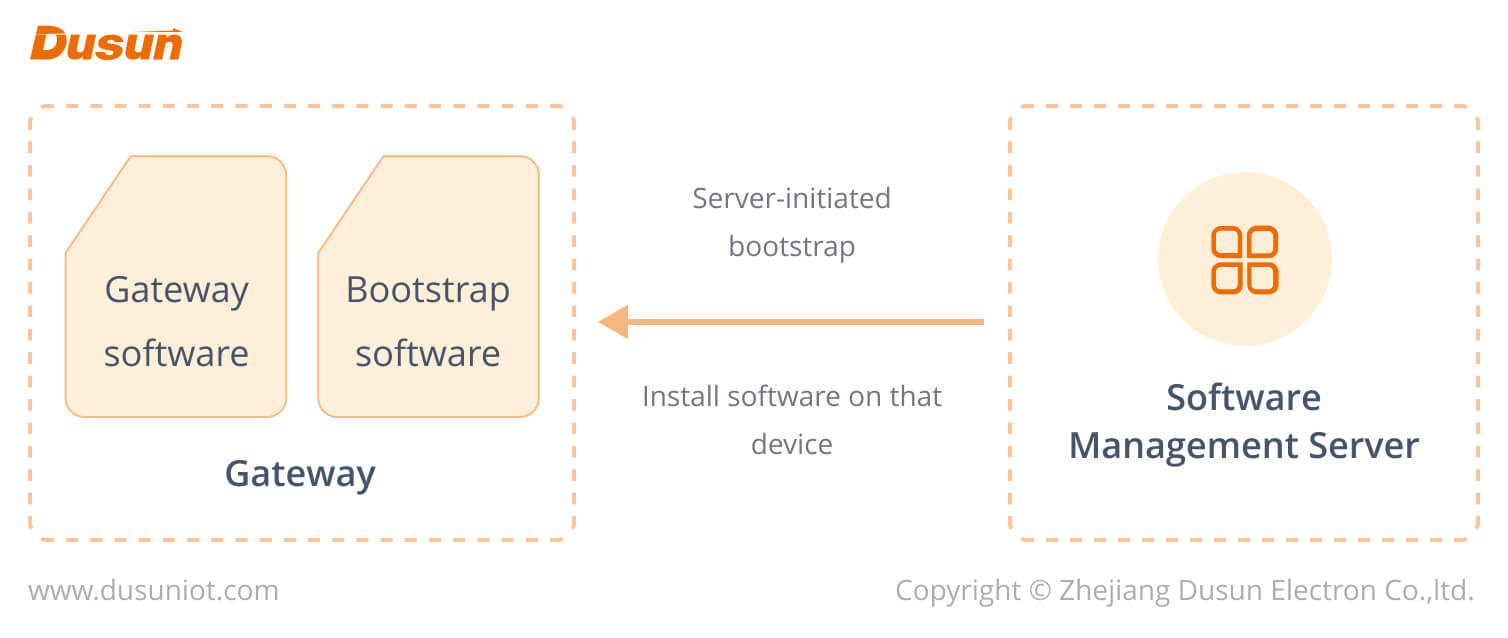
A very important feature of IoT gateways is the ability to download updates over the air. Keep in mind that once the gateway software is installed on the device and delivered to the field, you have very limited capabilities in terms of gateway software maintenance.
The ability to download software updates over the air is especially important from a security standpoint. It can impact the delivery time of critical security fixes because it does not require any centralized coordination of deployment operations. Each gateway device downloads software as soon as it is powered on.
What is an IoT Gateway Going to Do to Help You?
Some of the most common loT gateways examples include:
- Connecting devices to one another
- Connecting devices to the cloud
- Translating communication between loT devices that are manufactured or operated by different companies
- Filtering data
- Mitigating security risks
- Intelligence at the edge
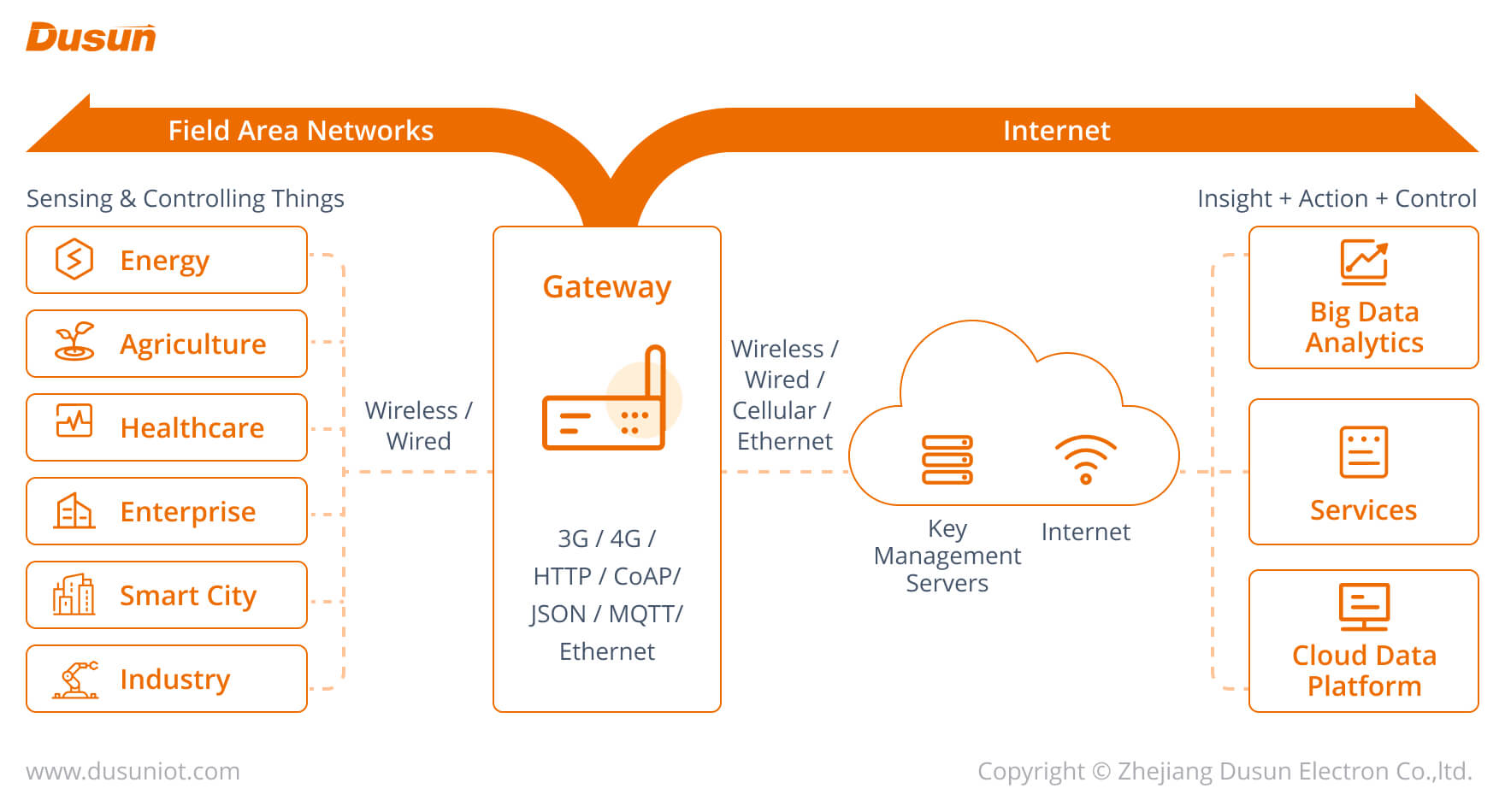
Connecting Hardware to the Cloud and Other Hardwares
Like universal remotes, think of loT gateways. Even though you can have various remote controls that each work with a different device, a universal remote allows you to manage every device from one location, saving you time and energy.
The devices can still function without IoT gateways and be controlled individually, but doing so is more difficult, and they cannot be set up to cooperate. An IoT gateway offers a single location where data is transmitted to and from devices as it serves as a central hub.
The cloud is used for this communication between users and other devices. You communicate with IoT devices through IoT gateways using cloud-enabled software when you send or receive information to them, such as a change in protocol.
A growing number of IoT devices and smart sensors are being used, and IoT gateways are able to connect to expand and streamline their functionality throughout a physical space. You can add devices quickly and easily while saving time and effort by installing universal IoT gateways early in your technology plan.
Translation of IoT Device Communication
Although IoT devices are quickly becoming a part of our daily lives and new products and services are constantly emerging to help with just about every aspect of our lives, there are currently no standards for a universal device language.
While your office might have lighting and climate control with motion sensors, it’s unlikely that they will be able to communicate with one another unless the same company made them or unless you have IoT gateways converting data between them. The importance of hubs in streamlining how IoT devices interact grows as more are added.
Data Filtering
The IoT gateway enables the communication between your loT devices and streamlines communication by filtering data into useful information. Being able to see every record would be useless and slow down how quickly the IoT devices can work and communicate because they can record new bits of data in a fraction of a second.
In order to improve communication and response times, IoT gateways are intelligent and capable of operating at the edge. Each gateway can consider and examine the provided data before sending only the necessary, filtered data to the cloud.
Protection and Risk Reduction
The security risks related to loT devices grow as their usage increases. You’ve probably heard horror tales about the Internet of Things gone awry, like smart cars going rogue or Wi-Fi baby monitors allowing hackers to listen in.
All Internet of Things (IoT) devices are susceptible to outside interference and hacking, but an IoT gateway adds another layer between the device and the internet. Even if your business isn’t going to invest heavily in the Internet of Things, a gateway enables future investment while enhancing security for IoT devices you already own.
At the Edge of Intelligence
It’s important to note that loT gateways are an example of “intelligence at the edge” or “intelligent edge.” This means that data can be processed and understood by the loT gateway itself rather than needing to be translated and processed by a third party or person. LoT gateways exemplify the intelligent edge in action.
Overview of IoT Protocols
When something goes wrong, a smart device can communicate with other devices (not just those of the same kind) and, if necessary, notify the user of the issue or automatically call for assistance, in contrast to its conventional counterpart, which remains silent. However, each of these interactions requires a communication channel, or a universal “language,” that all of the IoT ecosystem’s devices would share and be able to employ.
The IoT protocols, either the Internet protocols that have been around for a while or the IoT protocols explicitly created for connected device communication, serve as the medium within the Internet of Things. This is one of the explanations for why standardized IoT protocols are necessary for the Internet of Things. They reduce the risk of security threats by preventing further fragmentation.
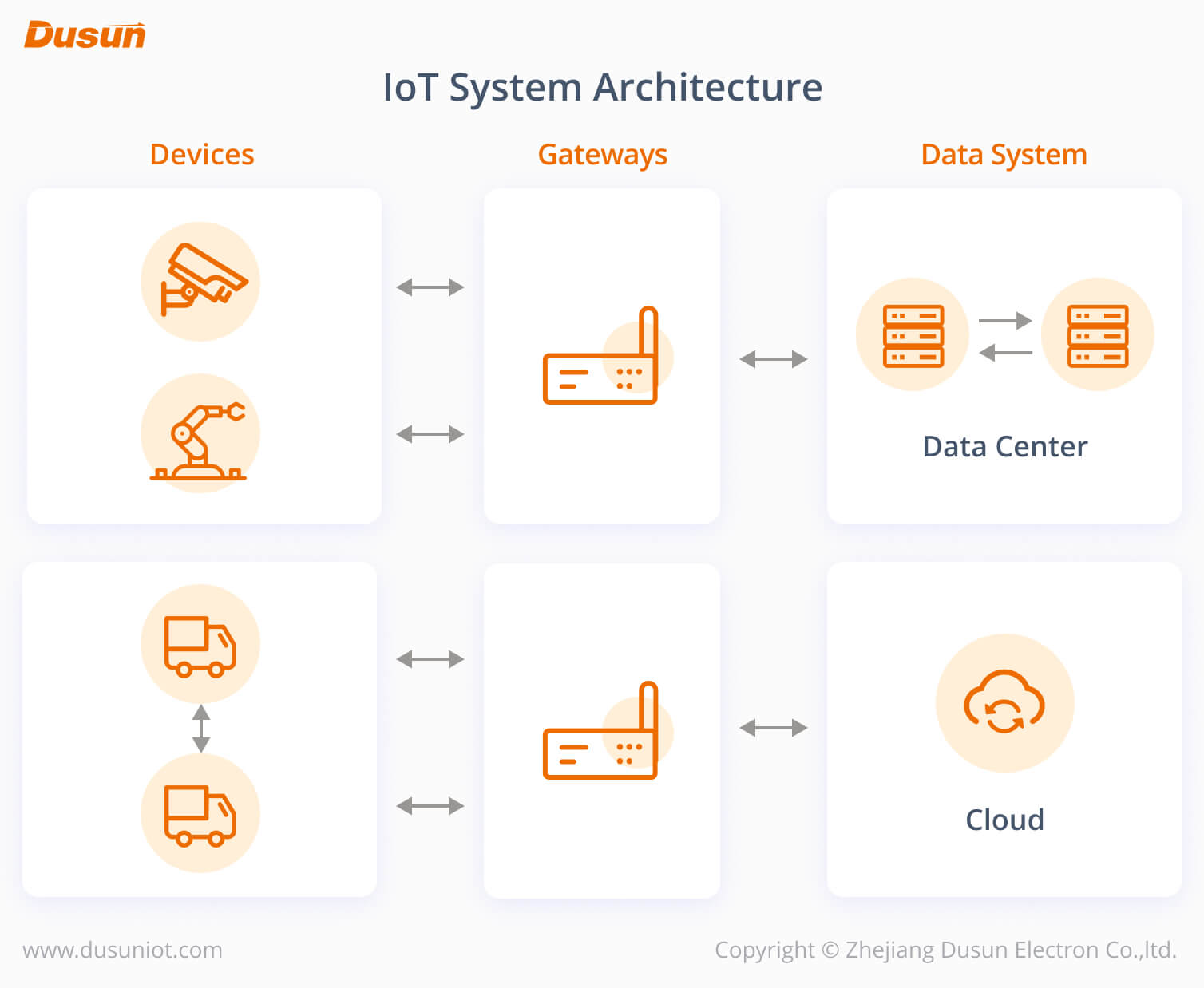
Message Queuing Telemetry Transport (MQTT)
A lightweight publication/subscription type (pub/sub) messaging protocol, Message Queuing Telemetry Transport is probably the Industrial Internet of Things standard that has seen the most adoption. MQTT‘s architecture is straightforward and light, resulting in low power consumption for devices that run on batteries.
It builds on the TCP/IP protocol and was created specifically for unreliable communication networks to address the issue of the growing number of small, inexpensive, low-power objects that have entered the network in recent years.
The subscriber, publisher, and broker model underlies MQTT. The publisher’s role in the model is to gather data and transmit it to subscribers via the mediation layer, which is the broker. Contrarily, the broker’s responsibility is to guarantee security by double-checking the legitimacy of publishers and subscribers. The publisher has the option to specify the quality of its message thanks to MQTT’s three modes for achieving this (Quality of Service):
QoS0 (At most once): The fastest and least dependable mode. Despite sending the publication, no confirmation was received.
The message will be delivered at least once, but duplicates may be received, according to QoS1.
The most dependable mode, QoS2 (exactly once), also uses the most bandwidth. To guarantee that the message is delivered only once, duplicates are controlled.
Due to its widespread use in IoT devices like electric meters, cars, detectors, and other industrial or sanitary equipment, MQTT is a good fit for the following requirements:
- Low bandwidth usage
- Utilizing wireless networks
- A minimal energy footprint
- Dependable when required
- Little memory and processing power
Despite its advantages, MQTT can present difficulties for some very constrained devices because it uses TCP for message transmission and has to deal with lengthy topic names. The MQTT-SN variant, which makes use of UDP and supports topic name indexing, resolves this.
The implementation of MQTT’s data management and device management capabilities is completely platform- or vendor-specific despite supporting a well-defined data representation and device management structure model.
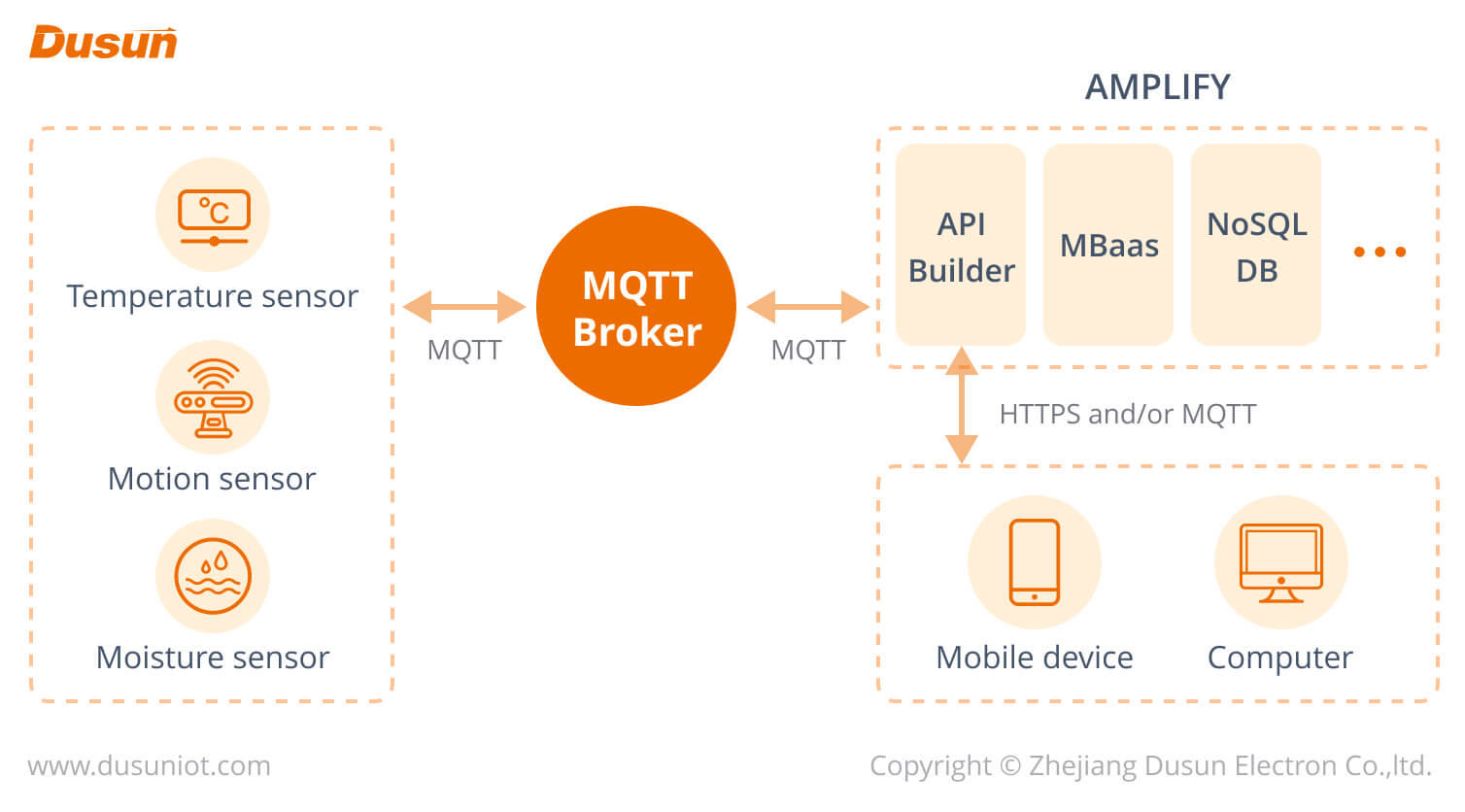
WiFi
Devices that can transmit wireless signals, such as telephones, computers, or routers, to name a few, are necessary to set up a Wi-Fi network. The internet connection is moved from a public network to a private home or office network at home using a router. Within a specific range, WiFi connects nearby devices to the Internet. By broadcasting a signal, computers or phones can share a wired or wireless internet connection with other devices, which is another way to use WiFi.
WiFi makes use of radio waves that transmit data on predetermined frequencies, like the 2.4 GHz or 5 GHz channels. Different wireless devices can operate on a variety of channels in both frequency ranges, which helps spread out the load and prevents interruptions to the connections of the individual devices. This largely prevents wireless networks from becoming overloaded.
The typical range of a standard WiFi connection is 100 meters. However, the most typical range is only 10 to 35 meters. The strength of the antenna or the transmission frequency has a significant impact on effective network coverage. Depending on the surroundings and whether it offers internal or external coverage, a WiFi Internet connection’s range and speed will vary. As a result, as a computer gets closer to the main source of the WiFi signal, its speed increases, and as it gets farther from the source, its speed decreases.
ZigBee
Low power consumption, low throughputs (up to 250 kbps), and connectivity ranges of 100 meters between nodes are characteristics of ZigBee-based networks and Zigebee IoT devices. Examples of typical applications are sensors, personal networks (WPAN), home automation, alarm systems, and monitoring systems.
In 2003, its original specification became an IEEE standard, and at the start of 2006, the first OEM modules that complied with it began to be sold in large quantities. As a self-configuring, short-range radio network standard, ZigBee was created with the purpose of being used in telemetry systems, for wireless reading of measurement results from energy and heat meters, etc., and for communication between various types of sensors and monitoring devices.
The ZigBee standard is a packet data exchange protocol that is relatively easy to use, resilient to communication errors and unauthorized readings, and frequently used in gadgets with minimal system requirements, like microcontrollers and sensors.
ZigBee IoT protocol is based on a self-assembling and self-healing grid topology, making it simple to install and maintain. These days, there are many ZigBee gateway suppliers offering devices that support this open standard, and it can scale easily to thousands of nodes.
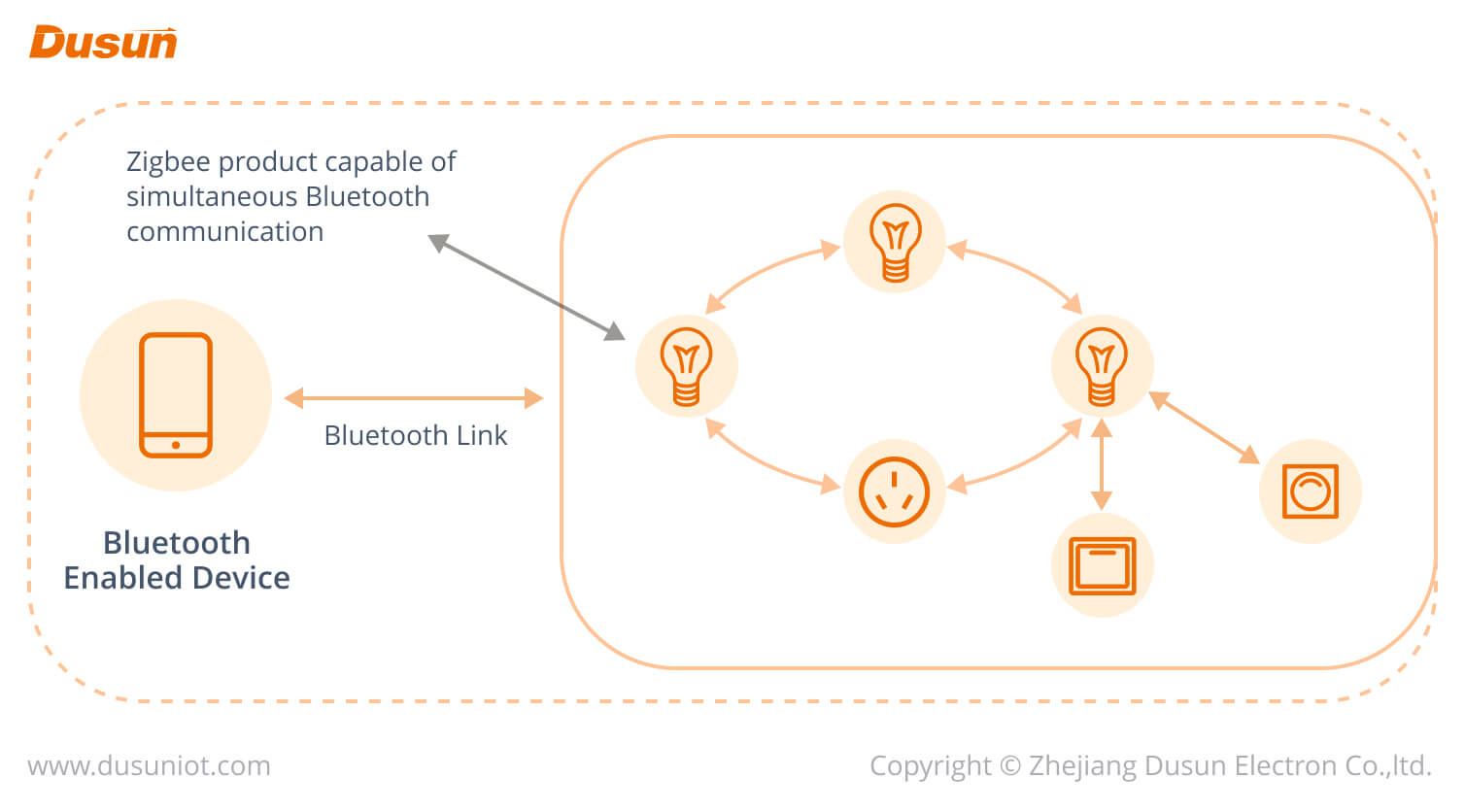
Bluetooth
A variety of electronic devices, including a phone, keyboard, computer, laptop, mouse, palmtop, printer, headset or speakerphone, and more, can be connected wirelessly thanks to Bluetooth technology. If you prefer a wiki-style explanation, this is an open standard that is detailed in the IEEE 802.15.1 specification.
Its technical specification includes three classes of ERP 1-3 transmission power with ranges of 100, 10, and 1 meter in open space. The second (10m) class, which enables you to connect devices in various rooms and even on different floors, is the most popular. The device that makes use of this standard—a Bluetooth adapter—uses radio waves in the 2.4 GHz ISM frequency band.
In Bluetooth technology, data is transmitted as packets to one of 79 channels with a bandwidth of 1 Mhz (in the case of the oldest Bluetooth 1.0 standard), ensuring a maximum transfer speed of 721 kbit/s.
A maximum data transfer rate of up to 3 Mb/s is ensured by the 40 channels and 2 Mhz bandwidth of the most recent Bluetooth 4.0 standard. It is important to be aware that older Bluetooth versions are compatible with newer standards, which ensure faster data transfer and greater security.
Further reading: What is a Bluetooth Gateway?
Metrics for a Good Gateway
Background
In recent years, driven by the Internet of Things technology, the smart home industry has developed rapidly, and more and more smart home devices with different functions have appeared.
In the basic smart home system, the home gateway, as the main hub of the system, connects the smart home devices internally for data aggregation and forwarding; externally connects to the control terminal to support users’ remote control and management of home devices.
At present, there are two ways of communication between smart home devices and smart home gateways: wired and wireless. Although the signal of the former is stable, it has the disadvantages of difficult wiring and high cost.
Therefore, with the vigorous development of wireless communication technology, communication distance, and signal stability are Enough for home use, so wireless communication gradually dominates the smart home field. At present, the mainstream wireless communication methods in the field of smart home are wifi, Bluetooth, Zigbee, and infrared.
With the increase of wireless communication protocols, there is no unified standard for the communication interface of smart home devices. Different devices use different communication protocols according to their own manufacturer’s design methods.
For example, a smart temperature and humidity meter can use the wifi communication protocol to upload data. Bluetooth communication protocol or Zigbee communication protocol can be used.
Users cannot directly communicate with smart devices using communication protocols such as Zigbee through mobile control terminals (such as mobile phones). The data information is forwarded to the user’s mobile phone.
At present, most home gateways on the market only support a single communication protocol, the application scenario is single, and the support device communication protocol is fixed, which cannot be well applied to the smart home field where multiple protocols coexist.
Due to the competition among smart home device brands, the home gateways produced by various manufacturers basically only support communication with their own brands of smart home devices. Even if some home gateways can support third-party devices, they still need user programming, which is not friendly enough for ordinary users.
Compatibility is too poor. For users, if they choose a certain brand of a gateway, they can only choose some smart home devices that support the communication protocol of the brand’s gateway, which brings great limitations to the user’s use.
If users choose different brands of smart home devices, they need to configure multiple home gateways, which increases the cost and system complexity, and products of different brands cannot be interconnected and cannot achieve intelligence in the IoT environment.
Multiprotocol Gateway
Devices from different manufacturers and different protocols cannot be interconnected, resulting in problems that reduce user experience. A good gateway can provide a gateway structure for multi-protocol conversion, which can realize multi-protocol analysis and break the problem of the inability to control communication between terminal devices due to different protocols.
DUSUN multi-protocol gateway supports Celluar LTE, Wi-Fi, Zigbee, BLE, Z-WAVE, Sub-G, LoRa, and other protocols. The multi-protocol gateway can connect to the network via Wi-Fi LTE, Zigbee, BLE, and Z-WAVE to connect devices.
The DUSUN gateway can realize multi-protocol analysis, and users can easily select the desired protocol, reducing costs and steps. At present, DUSUN’s technology has obtained Zigbee, BQB certificate, ensuring that our products are sold locally by the laws and regulations.
For consumers, when choosing a gateway, choose products with as many protocols as possible. Also, a good gateway should have a lithium battery. In the event of a power outage or lack of power, such gateways remain operational, ensuring data security and stability. DUSUN’s gateway series products are equipped with lithium batteries, which minimizes worries for customers.
It is worth mentioning that, integrating multiple antennas into one device, how to ensure that they do not interfere with each other is a difficult problem encountered by many manufacturers. DUSUN solves this problem from a technical level.
Top Cloud Services for Connecting an Internet of Things Gateway
The capabilities of Internet of Things devices and cloud computing are brought together by the Internet of Things cloud platforms, which are then provided as an end-to-end service. Currently, many Internet of Things (IoT) Cloud Platforms are available on the market.
These platforms are provided by a variety of service providers and carry a wide variety of applications. This section has compiled a list of some of the most reliable cloud services for your consideration.
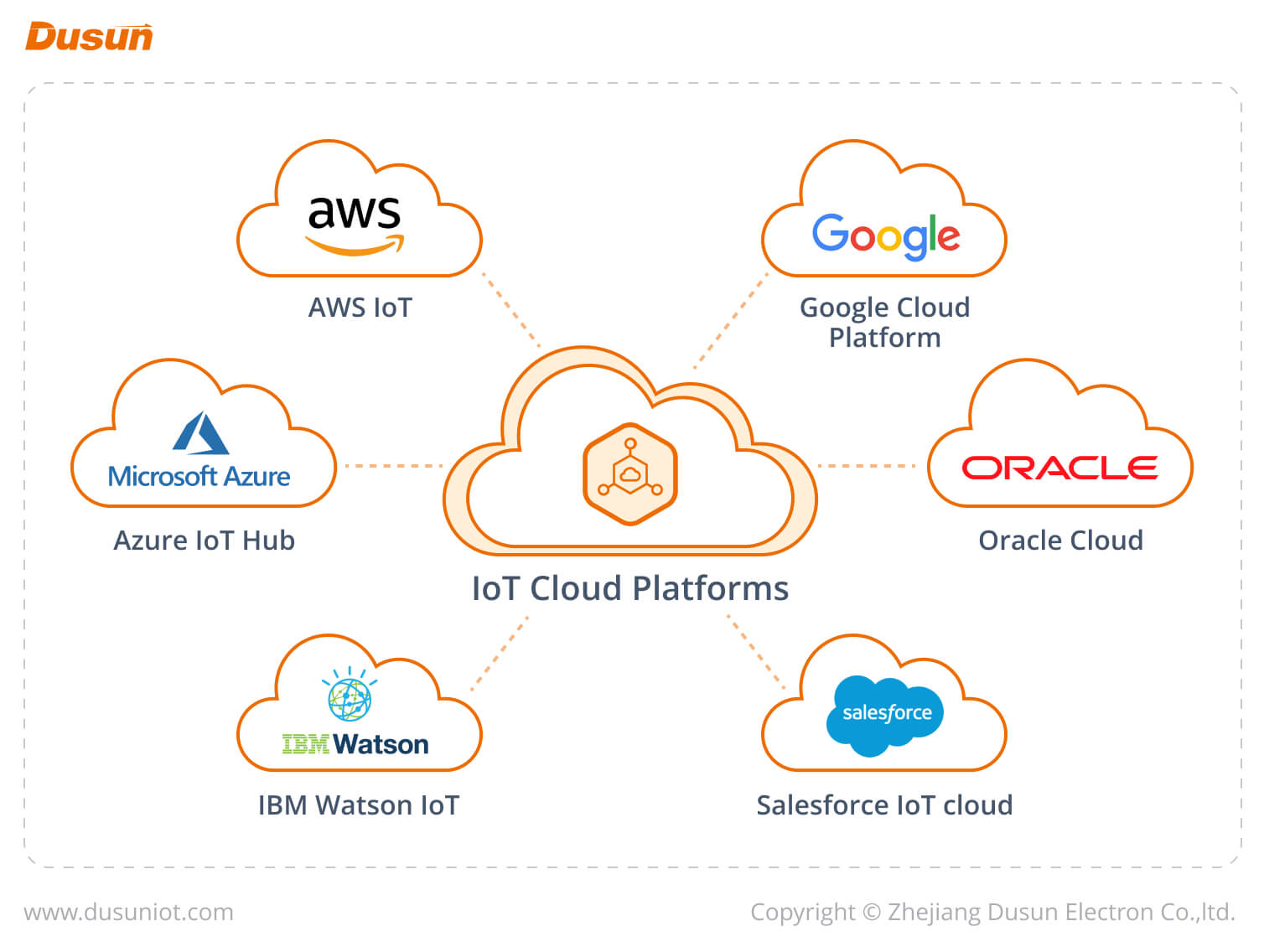
Your individual requirements are ultimately the most important factor to consider when deciding which cloud service provider to go with. You are required to consider the following aspects when selecting the appropriate platform for your needs:
the ability to capture real-time data, the performance of data analytics, device configuration, API protocols, and the type of cloud model, amongst other considerations. The expense incurred during use is obviously yet another important aspect that can’t be neglected.
IoT Edge Security
Security breaches are known to be extraordinarily common on IoT devices. Surprisingly, IoT devices have poor security, making them easy targets for cyberattacks. Additionally, an attack on your IoT devices opens up vulnerabilities for multiple device exposure, leaving the entire ecosystem vulnerable.
By using IoT Gateways, you can strengthen the IoT ecosystem’s cybersecurity by adding more protection layers to your connected devices. IoT devices are more susceptible to hacking when they are directly connected to the internet, so an IoT gateway reduces the number of devices that are connected to the internet.
An IoT gateway is an example of an intelligent IoT device installed at the network edge. Both advantages and disadvantages for IoT security can be provided by these devices, including:
Data minimization: Before being sent over the Internet, data generated by IoT devices must be filtered by IoT gateways. This aids in lowering the amount of data sent and the potential for network communications or compromised cloud-based servers to leak sensitive data.
IoT gateways have limited data processing capabilities, which have advantages and disadvantages for security. Edge computing for distributed data processing aids in resiliency and data minimization, but distributed architectures may be more challenging to secure because perimeter-based defenses cannot shield them.
IoT gateways with built-in security features that sit between IoT devices and the open Internet can use edge-based security. Because the IoT helps to close the security gaps that are frequently present in IoT devices, this can help to protect an organization’s IoT devices and the sensitive data that they collect from cyber threats.
Fields Where IoT Gateways Are Applicable
Industrie 4.0 (IIoT)
First, think about the operating system of the gateway and whether it is appropriate for use with your current hardware. If it’s open-source, you have the flexibility to make the necessary adjustments. Consider the software the gateway provides for data acquisition as well.
IIoT gateways need to be able to manage local connections with dated technology that wasn’t made for internet connectivity. This data must be accessible to the gateway in order to be combined with data from other sources, such as MQTT protocols and C/Python APIs.
Real-time analytics can be a helpful tool in IIoT deployments. For instance, if a machine breaks down on the assembly line of a factory, a gateway with the ability to recognize and react to that anomaly can assist you in fixing the issue quickly—before you’ve shipped out several hundred defective products.
Make sure the gateway you choose has remote access capabilities in addition to edge analytics capabilities, so you can manage alerts and review data while you’re not on-site.
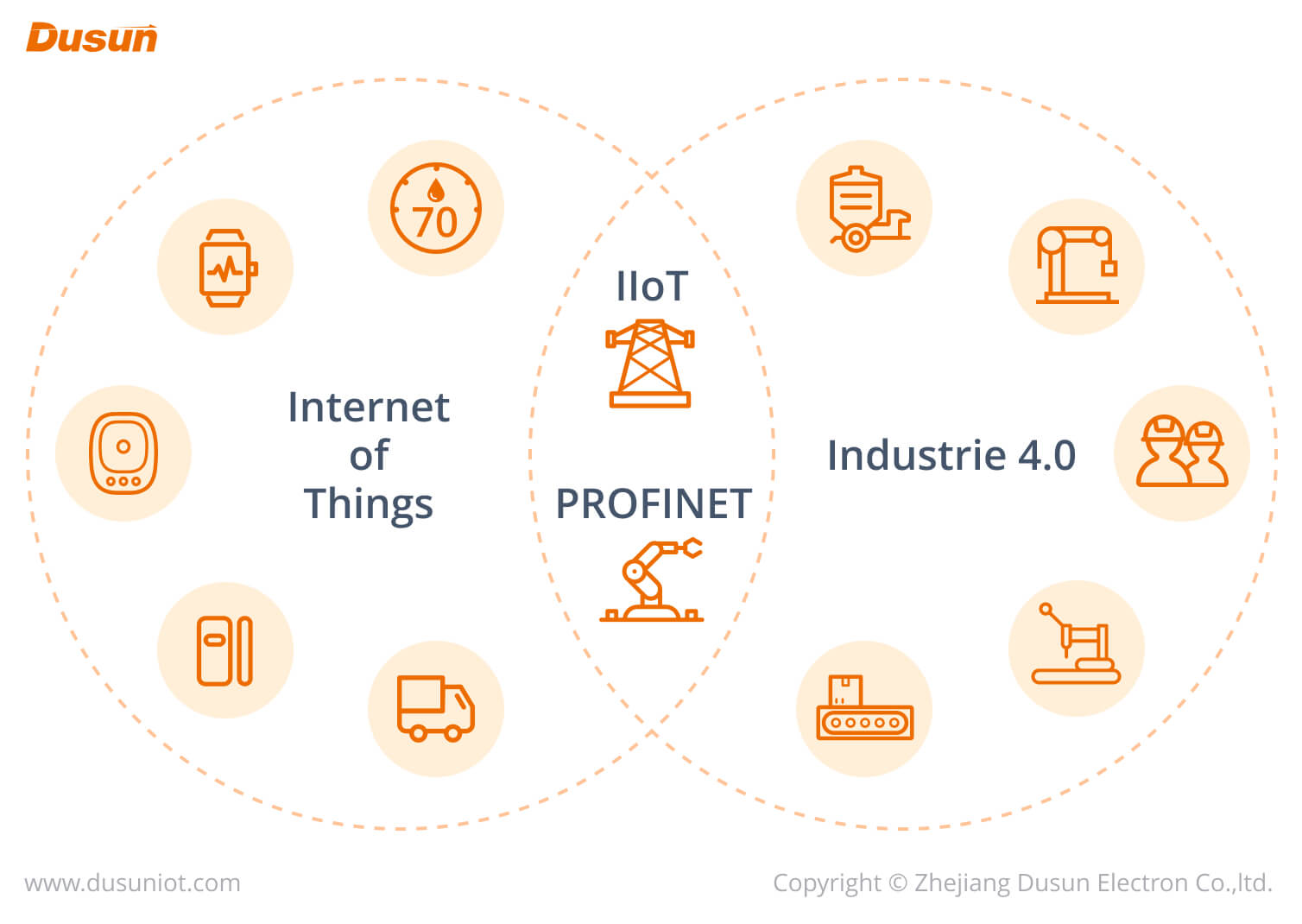
Healthcare
Once more, start with the fundamentals: is the operating system of the gateway compatible with your current hardware and any connected medical devices? Can it communicate with legacy systems not built with the internet in mind?
You should also pay close attention to patient privacy, data security, and compliance with legal mandates like HIPAA when using IoT in healthcare. To improve data privacy, many healthcare facilities use closed networks, and your IoT gateway may need to meet certain requirements to be used.
Look for a remote patient monitoring device company that frequently collaborates with healthcare organizations to ensure that the gateway you select offers the required level of security. Find out from other healthcare IoT managers which gateway model and brand they preferred and why.
The Smart City
Many different connected device types are deployed in “smart cities,” including connected cars, traffic control systems, first aid equipment, construction sensors, and smart energy meters. Since the majority of sensors are based on LPWAN technologies like NB-IoT and Cat-M1, IoT gateways for smart cities must offer a wide range of input options for low-power devices in order to accommodate all of these.
The gateway itself should be energy-efficient to reduce costs, but it should also have edge processing and analytics capabilities. Look for products that offer a safe path for data transfer, like a VPN tunnel.

Agriculture
Similar to smart cities, agriculture IoT deployments frequently rely on low-power equipment placed in outlying locations. To connect with your cloud management system, look for a LoRaWAN gateway that can take input from these devices and translate it as necessary.
Like IIoT, edge processing may be advantageous for smart agriculture because it enables quick responses to issues. To avoid wasting water (or flooding a field) while diagnosing the issue, the gateway, for instance, can initiate an automatic shutoff if a sensor detects a leak in the waterline of an irrigation system.

More advanced, BLE mesh protocol-based solution run on Home Assistant, which aims to help control grow lights. The solution includes functions like ON/OFF, brightness adjustment, CCT adjustment, etc. To meet the plant growth requirements, as the growing conditions change(e.g., temperature, humidity, brightness…), the lights can be adjusted automatically to fit the environment. The core device of this solution is the Home Assistant gateway (DSGW-210-HA), which truly realizes all-round convenience.
Bottom Line
The above is the most comprehensive knowledge about IoT gateways. For more information, you can visit https://www.dusuniot.com/solution/ to find more areas where smart gateways can be applied and their solutions. These areas include smart apartments, smart aged care, and smart lighting, which achieves a combination of practicality and high performance.
What is the difference between IoT platform and IoT gateway?
IoT platforms and IoT gateways are completely distinct from one another. In contrast to IoT Platform, which is cloud-based software used for device management, storage, and analysis, IoT gateway is a programmed hardware device at the edge of sensor network.
What are IoT systems now also called?
Industrial gateway collects and analyze data from operational technology (OT), connected locations, and people. IIoT aids in regulating and monitoring industrial systems when used in conjunction with OT monitoring tools.
Can I build my own IoT platform?
The biggest cost-saving option is to build your own IoT platform, which can also be a rewarding learning experience and provide you control over your project.
How long do IoT devices last?
For most IoT applications the device life cycle is 10 to 20 years or more. But ‘Low power’ is really a manifestation of a much broader and more universal problem wireless connectivity needs to solve for the IoT: longevity. Longevity is defined as long life expectancy or in terms of technology: a long device life cycle.
What Are the Differences Between an IoT Gateway and a Router?
IoT Gateways and routers both function as a bridge that connects various types of devices and communication technologies. Although an IoT Gateway and a router are very similar, an IoT Gateway performs far more functions. Simply put, an IoT Gateway can perform complex tasks both offline and online, whereas a router can only bridge devices to the internet when it is online.






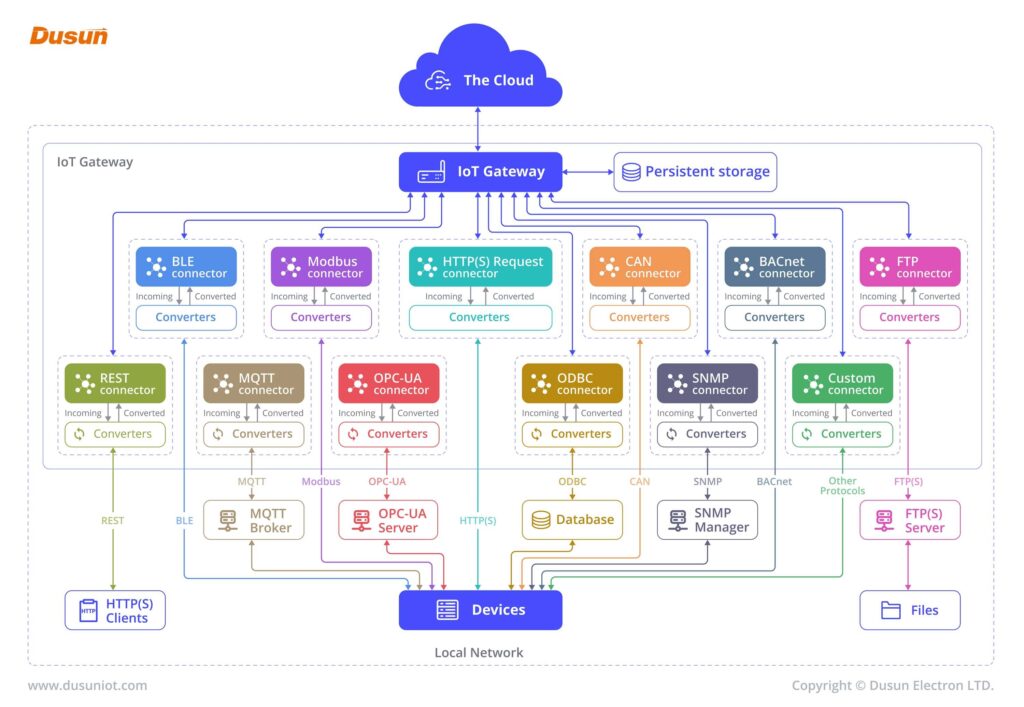







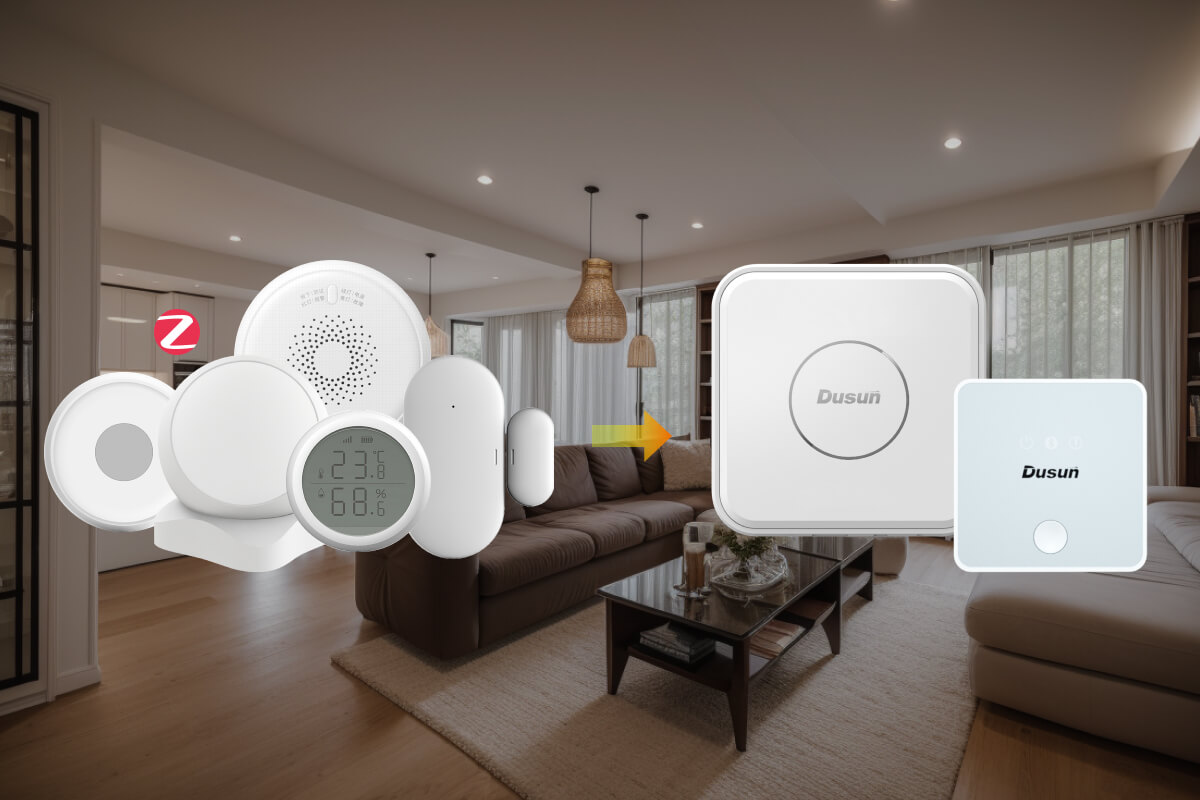
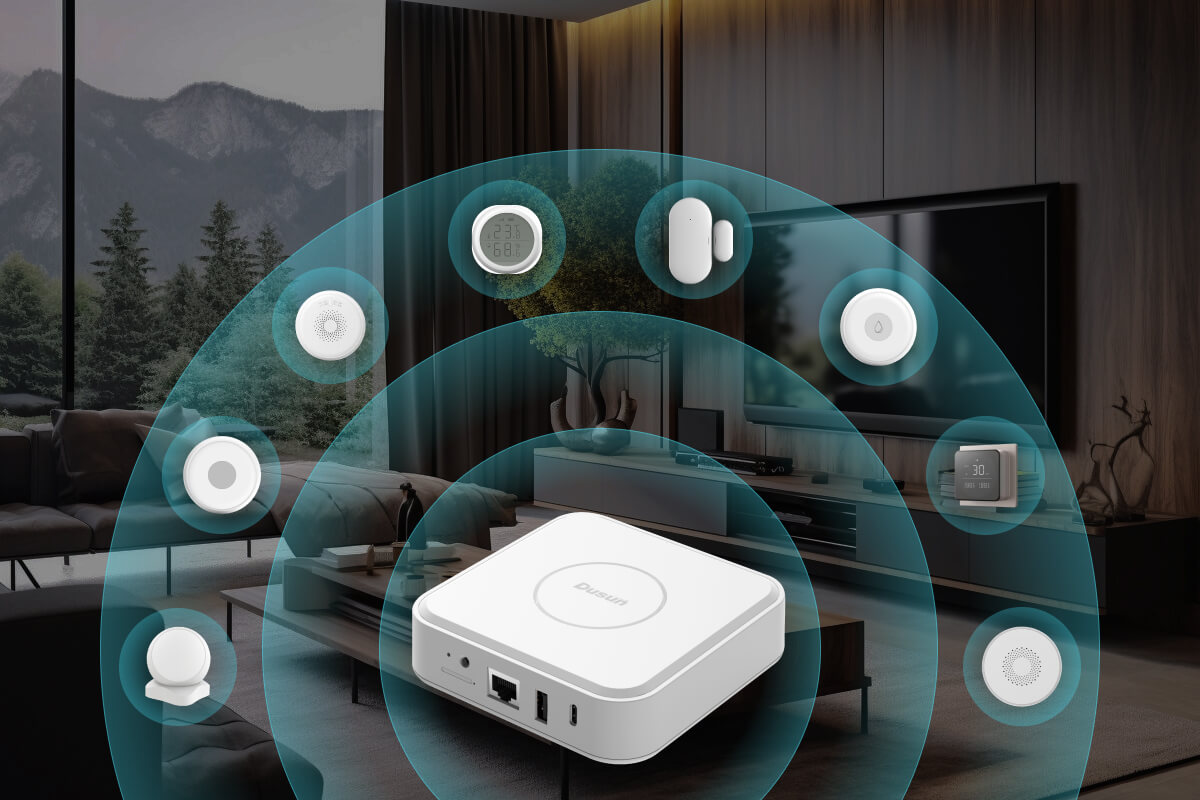
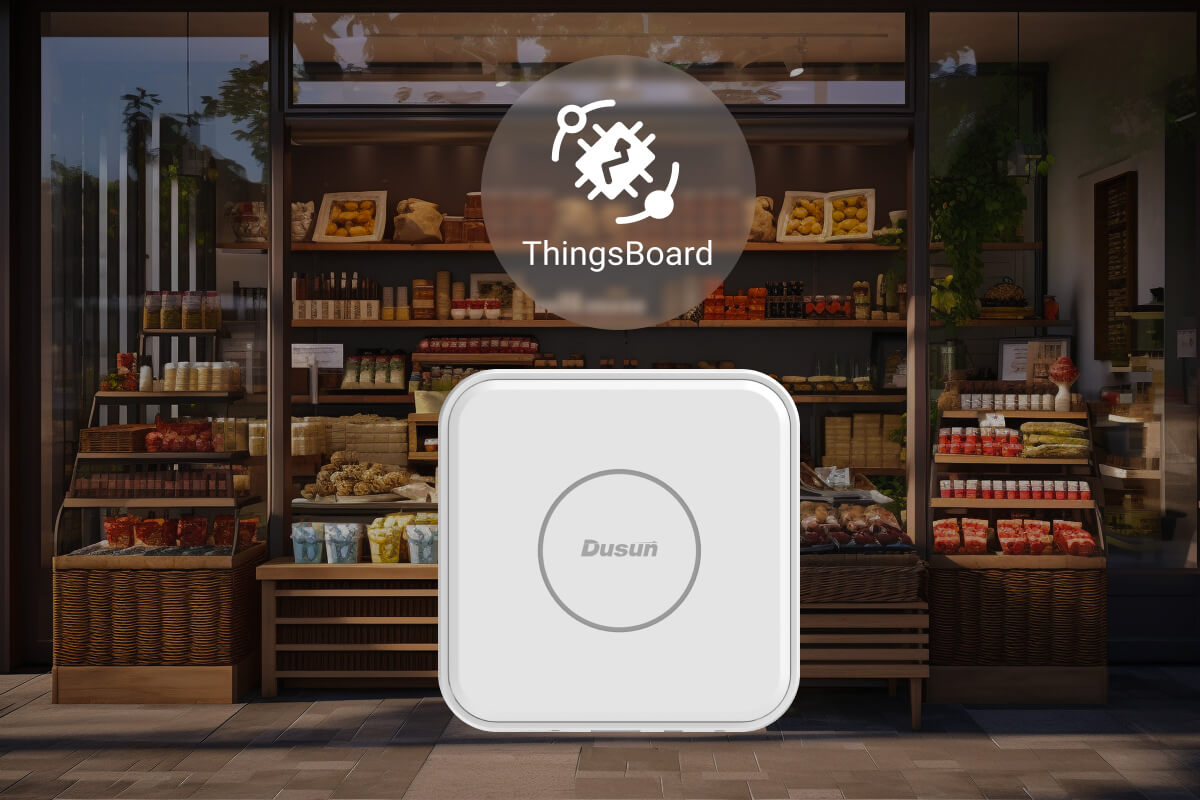
One Response